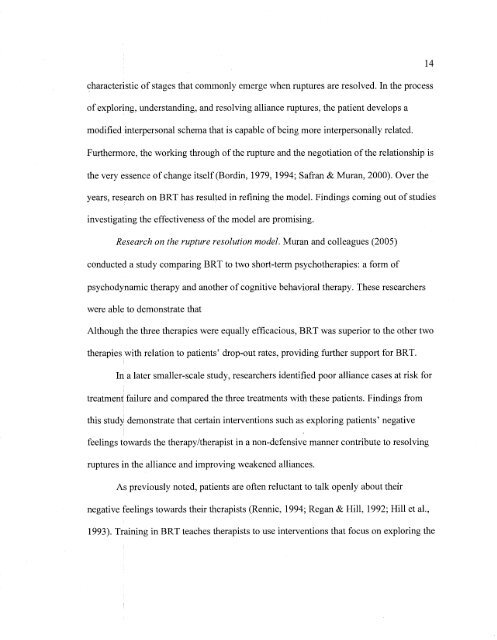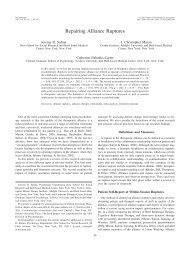Download - The Safran Lab
Download - The Safran Lab
Download - The Safran Lab
Create successful ePaper yourself
Turn your PDF publications into a flip-book with our unique Google optimized e-Paper software.
characteristic of stages that commonly emerge when ruptures are resolved. In the process<br />
of exploring, understanding, and resolving alliance ruptures, the patient develops a<br />
modified interpersonal schema that is capable of being more interpersonally related.<br />
Furthermore, the working through of the rupture and the negotiation of the relationship is<br />
the very essence of change itself (Bordin, 1979, 1994; <strong>Safran</strong> & Muran, 2000). Over the<br />
years, research on BRT has resulted in refining the model. Findings coming out of studies<br />
investigating the effectiveness of the model are promising.<br />
Research on the rupture resolution model. Muran and colleagues (2005)<br />
conducted a study comparing BRT to two short-term psychotherapies: a form of<br />
psychodynamic therapy and another of cognitive behavioral therapy. <strong>The</strong>se researchers<br />
were able to demonstrate that<br />
Although the three therapies were equally efficacious, BRT was superior to the other two<br />
therapies with relation to patients' drop-out rates, providing further support for BRT.<br />
In a later smaller-scale study, researchers identified poor alliance cases at risk for<br />
treatment! failure and compared the three treatments with these patients. Findings from<br />
this study demonstrate that certain interventions such as exploring patients' negative<br />
feelings towards the therapy/therapist in a non-defensive manner contribute to resolving<br />
ruptures in the alliance and improving weakened alliances.<br />
As previously noted, patients are often reluctant to talk openly about their<br />
negative feelings towards their therapists (Rennie, 1994; Regan & Hill, 1992; Hill et al.,<br />
1993). Training in BRT teaches therapists to use interventions that focus on exploring the<br />
14



